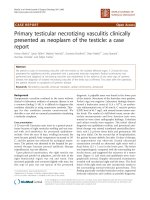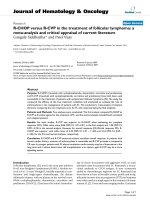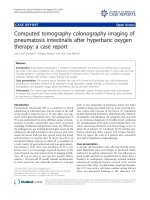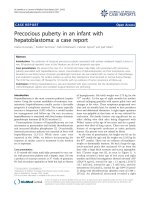Báo cáo khoa hoc:" Complicated Crohn''''s-like colitis, associated with Hermansky-Pudlak syndrome, treated with Infliximab: a case report and brief review of the literature" pot
Bạn đang xem bản rút gọn của tài liệu. Xem và tải ngay bản đầy đủ của tài liệu tại đây (961.23 KB, 7 trang )
BioMed Central
Page 1 of 7
(page number not for citation purposes)
Journal of Medical Case Reports
Open Access
Case report
Complicated Crohn's-like colitis, associated with
Hermansky-Pudlak syndrome, treated with Infliximab: a case
report and brief review of the literature
George Kouklakis
1
, Eleni I Efremidou*
2
, Michael S Papageorgiou
2
,
Evdoxia Pavlidou
2
, Konstantinos J Manolas
1,2
and Nikolaos Liratzopoulos
2
Address:
1
Endoscopy Unit of University General Hospital of Alexandroupolis, Democritus University of Thrace, Alexandroupolis, Greece and
2
First
Department of Surgery of University General Hospital of Alexandroupolis, Democritus University of Thrace, Alexandroupolis, Greece
Email: George Kouklakis - ; Eleni I Efremidou* - ; Michael S Papageorgiou - ;
Evdoxia Pavlidou - ; Konstantinos J Manolas - ; Nikolaos Liratzopoulos -
* Corresponding author
Abstract
Introduction: Hermansky-Pudlak syndrome (HPS) is a rare autosomal recessive inherited
disorder consisting of a triad of albinism, increased bleeding tendency secondary to platelet
dysfunction, and systemic complications associated with ceroid depositions within the
reticuloendothelial system. HPS has been associated with gastrointestinal (GI) complications
related to chronic granulomatous colitis with pathologic features suggestive of Crohn's disease.
This colitis can be severe and has been reported to be poorly responsive to medical therapies
including antibiotics, corticosteroids, sulfasalazine, mesalamine and azathioprine.
Case presentation: We report a patient with HPS which was complicated by inflammatory bowel
disease with clinical and pathologic features of Crohn's disease, refractory to antibiotics,
corticosteroids and azathioprine. A trial of infliximab was attempted and repeated infusions
produced a complete response.
Conclusion: The occurrence of ileitis and perianal lesions and also the histopathological findings
in our case suggest that HPS and Crohn's disease may truly be associated. Given this similarity and
the failure of the standard medical therapy of corticosteroids and azathioprine, our patient received
infliximab with marked clinical improvement.
Introduction
Hermansky-Pudlak syndrome (HPS) is a complex syn-
drome with a triad of manifestations of tyrosinase-posi-
tive oculocutaneous albinism (Ty-pos OCA), bleeding
diathesis resulting from platelet dysfunction, and systemic
complications associated with accumulation of ceroid
lipofusion. Complications of the syndrome such as renal
failure, cardiomyopathy, fatal pulmonary fibrosis and
granulomatous colitis have been described [1,2].
Specifically, the colitis is a unique type of inflammatory
bowel disease which can be severe and even fatal, with
clinical features suggestive of chronic ulcerative colitis and
pathological features more closely similar to those of
Crohn's disease [3]. It is still unclear whether the granulo-
Published: 8 December 2007
Journal of Medical Case Reports 2007, 1:176 doi:10.1186/1752-1947-1-176
Received: 6 June 2007
Accepted: 8 December 2007
This article is available from: />© 2007 Kouklakis et al; licensee BioMed Central Ltd.
This is an Open Access article distributed under the terms of the Creative Commons Attribution License ( />),
which permits unrestricted use, distribution, and reproduction in any medium, provided the original work is properly cited.
Journal of Medical Case Reports 2007, 1:176 />Page 2 of 7
(page number not for citation purposes)
matous colitis in HPS is because of ceroid deposition or
reflects the coexistence of Crohn's disease and HPS.
An analysis of most reported cases, since Schinella et al.
first reported granulomatous colitis in association with
HPS (1980), suggests that the colitis of HPS is simply a
reaction to the tissue deposition of ceroid [4]. Yet, there
are reported cases of HPS with gastrointestinal complica-
tions related to chronic granulomatous colitis, enterocol-
itis, ileitis, intestinal fistulization or granulomatous
perianal disease [2-5]. These observations suggest that the
colitis of HPS is due to the development of classical
Crohn's disease. Therefore, it is possible that treatments
known to be effective for Crohn's disease would be effec-
tive for HPS-associated enterocolitis [3,4]. A review of
reported cases reveals no consistent success with the
standard medical treatment including sulfasalazine,
mesalamine, corticosteroids and antibiotics, such metro-
nidazole and ciprofloxacin [3]. In some cases surgical
intervention is necessary, while subtotal colectomy or
total proctocolectomy has been performed as a last resort
[1].
We, therefore, report here the occurrence of a classical
clinical and pathologic picture of Crohn's disease in a
woman with HPS and our experience with infliximab in
treating successfully this HPS-associated enterocolitis.
Case presentation
A 42-yr-old muslim woman with hallmark findings of
HPS presented to the University Hospital of Alexandro-
poulos in 2005 complaining of an 10-month history of
recurrent episodes of abdominal pain worse with defeca-
tion and intermittent bloody diarrhea. She had lost 10
pounds over 6 months. According to her history, HPS was
diagnosed elsewhere in 2002 [tyrosinase-positive oculo-
cutaneous albinism (Ty-pos OCA) and normal platelet
count with small quantity of dense bodies (DB), without
genetic linkage analysis]. Family history was significant
with a sister with albinism who had died at age 36.
Initial physical examination revealed an albino woman
with whitish hair, pale and unpigmented skin and strabis-
mus. Ocular examination showed horizontal nystagmus
with reduced vision and no pigmentation of the iris. Car-
diopulmonary and abdominal examinations were nor-
mal. Chest x-ray and high-resolution CT didn't show any
signs of pulmonary fibrosis. Baseline laboratory values
were within normal range, including a normal platelet
count (401 × 10
9
/L) and no signs of hemorrhagic diathe-
sis were observed. However, platelets were small in size
(MPV 8fL). Platelet aggregation tests (PFA with collagen/
ADP and collagen/epinephrine) were within normal
range. Bone marrow aspiration revealed the presence of
pseudo-Gaucher-like appearance histiocytes.
Differential diagnosis of the colitis included the granulo-
matous enterocolitis found in HPS-patients, ulcerative
colitis, Crohn's disease, tuberculous (TB) colitis and other
forms of inflammatory bowel disease. For the possibility
of tuberculosis of the intestine, at first, a tuberculin skin
test was performed, which was negative.
Rectal examination revealed skin tags and a posterior fis-
sure with no obvious abscess. Colonoscopy revealed
severe segmental colitis with multiple ulcers in the sig-
moid colon (Figure 1) and numerous deep ulcers in the
terminal ileum (Figure 2), with sparing of the remainder
of the colon. No active bleeding was seen. This endo-
scopic appearance was highly reminiscent of Crohn's dis-
ease. Upper endoscopy showed no evidence of upper GI
bleeding or other pathology. Contrast enhanced CT of the
abdomen showed thick-walled loops of ileum and sig-
moid colon, without evidence of obstruction or perfora-
tion. Histologic findings of biopsy samples from the
ileum and sigmoid showed focal chronic inflammation,
irregular villous architecture and granuloma formation
with no obvious ceroid deposition. All the mucosal biop-
sies from the ileum and different colonic segments,
included those from ulcer bases, were negative for Myco-
bacterium tuberculosis.
Over the next two weeks her symptoms progressed with
increased pain with defecation and bloody diarrhea. Dur-
ing this time, the patient was treated with parenteral nutri-
tion, steroids and antibiotics (metronidazole and
ciprofloxacin). Treatment with azathioprine (AZA) 100
mg/daily was begun with little effect. This therapy resulted
in temporary improvement but two weeks later the
patient's overall condition acutely worsened and she
developed drainage from the perianal fistula.
Colonoscopy at that time revealed severe ileitis, multiple
linear ulcers with edema and erythema in the sigmoid
colon and mild proctitis.
She was started on infliximab 5 mg/Kg and azathioprine
100 mg/daily. Within 72 hours this treatment led to
improvement in symptoms. The patient had soft tools
without blood and only minimal pain and drainage from
the fistula.
She again received infliximab (5 mg/Kg) at 2 and 6 weeks
following the initial dose with marked improvement of
her colitis, as seen on repeat colonoscopy, (Figures 3 and
4) and healing of the fistula.
On a maintenance regimen of AZA 100 mg/daily and a
dose of infliximab 5 mg/Kg/8 wk the patient has remained
well for the past 13 months.
Journal of Medical Case Reports 2007, 1:176 />Page 3 of 7
(page number not for citation purposes)
Discussion
Granulomatous colitis was an unrecognized complication
of HPS until its first description by Schinella et al [1].
Since then, HPS-associated colitis has been reported sev-
eral times. Witkop et al [6,7], Sherman et al [8] and
recently Hussain et al [9], Hazzan et al [3] and Grucela et
al [4] all described patients with HPS complicated by
granulomatous colitis, enterocolitis and, in some cases,
perianal disease.
A review of the English language medical literature identi-
fied a total of 13 patients with HPS who required surgery
due to lower GI bleeding, intractable colitis or perianal
disease [3]. The granulomatous colitis associated with
HPS usually manifests in the first and second decades and
has been described as having a clinical presentation simi-
lar to chronic ulcerative colitis and pathologic findings
consistent with Crohn's disease [3,4,8].
Colonoscopy commonly reveals multiple scattered super-
ficial and deep ulcers, with pseudopolyps in some cases,
from the rectum to cecum [4]. To our knowledge small
bowel inflammation has been described in only three
patients [1,3].
Histologically, broad ulcers, which extend into the mus-
cularis mucosa, brown granular pigmentation and non-
necrotizing granulomas are seen [1,9,10]. Specifically it
has been noted that the granulomas are not formed in
relation to deposits of the ceroid-like pigment [1].
Colonoscopy of the sigmoid colon: colitis with edema, erythema and multiple ulcersFigure 1
Colonoscopy of the sigmoid colon: colitis with edema, erythema and multiple ulcers.
Journal of Medical Case Reports 2007, 1:176 />Page 4 of 7
(page number not for citation purposes)
In our case, the patient was found to have segmental
severe granulomatous colitis with linear ulcers in the sig-
moid colon and multiple aphthoid ulcers in the terminal
ileum while pathological features were almost indistin-
guishable from those of Crohn's disease,, including
chronic inflammation, crypt architectural abnormalities
and epithelioid granulomas without ceroid deposition.
In addition, our patient had perianal disease with inflam-
mation and fistula, a complication characteristic of
Crohn's disease that has been previously described by
Sherman et al in 1989 [8] and by Hazzan et al in 2006 [3].
The clinical and pathologic findings described herein are
most consistent with a Crohn's-like phenotype.
The pathogenesis of bowel involvement in HPS is
unknown. It has been suggested that the granulomatous
colitis of HPS results from the accumulation of ceroid-like
pigment in intestinal macrophages, rupture of them,
release of lysosomal hydrolases and resultant tissue dam-
age [1,3,4,7-9]. An autopsy study by Sherman et al.
showed deposition of ceroid-like pigment throughout the
GI tract, which was often associated with lymph follicles
in the absence of colitis [8]. In the case of granulomatous
colitis, pigment remained sparse but was markedly
increased in pericolonic lymph nodes draining areas of
active colitis [8]. Regarding the absence of ceroid pigment
in our case, others have noted that relatively small quan-
tities of ceroid are deposited in the bowel and that any
deposits can be very focal [1]. Previously published
reports have indicated that medical treatment of granulo-
matous colitis associated with HPS has been unsuccessful.
Given the clinical similarity of HPS colitis to Crohn's dis-
ease, the therapeutic approach to patients with HPS-asso-
ciated colitis is similar to treatment for Crohn's disease,
including corticosteroids, antibiotics and immunomodu-
lators.
Colonoscopy of the terminal ileum: ileitis with multiple aphthoid ulcersFigure 2
Colonoscopy of the terminal ileum: ileitis with multiple aphthoid ulcers.
Journal of Medical Case Reports 2007, 1:176 />Page 5 of 7
(page number not for citation purposes)
However, a review of the literature reveals no consistent
success with the standard medical therapy used in treating
Crohn's disease and in some of these cases surgical inter-
vention was necessary [3]. Infliximab is a chimeric mono-
clonal antibody which has recently proven effective in
patients with Crohn's disease refractory to current medical
therapy and it is also used as a first line agent in severe
perianal fistulizing disease. There are recently published
reports of patients with HPS complicated by granuloma-
tous colitis refractory to medical therapy with antibiotics,
corticosteroids and immunomodulators but responsive to
treatment with infliximab [2,4,5].
This was the finding in our patient as well; treatment with
infliximab showed immediate improvement and there
was a complete response to repeated infusions of inflixi-
mab. This is the second report of HPS-associated granulo-
matous colitis with severe Crohn's-like ileitis which
dramatically responded to treatment with infliximab.
Conclusion
It is still unclear if the granulomatous colitis associated
with HPS is part of the syndrome or if it represents an
independent but associated process, such as Crohn's dis-
ease. The fact is that granulomatous enterocolitis in sev-
eral patients with HPS phenotypically appears like, and
clinically behaves like, Crohn's disease. It is also a fact that
infliximab results in a response in some of these patients.
In addition, the fact that infliximab results in a response
in some of these patients suggests that HPS may be linked
to Crohn's disease, or at least that TNF-a plays a pivotal
role in both types of colitis.
It should be noted that treatment success with infliximab
is still based on limited experience and only in patients
with HPS-associated Crohn's-like enterocolitis and it
should not be generalized as the optimal therapeutic
approach to all patients with granulomatous colitis com-
plicating HPS. More research is needed to determine the
Improvement of ileitis, healing of ulcers (after 8 wk of the initial dose of infliximab)Figure 3
Improvement of ileitis, healing of ulcers (after 8 wk of the initial dose of infliximab).
Journal of Medical Case Reports 2007, 1:176 />Page 6 of 7
(page number not for citation purposes)
cause of the granulomatous enterocolitis of HPS and also
possible common genetic linkages with Crohn's disease.
Competing interests
The author(s) declare that they have no competing inter-
ests.
Authors' contributions
GK conceived of the study and participated in its design
and coordination. EIE participated in the design of the
study, the acquisition and interpretation of data and
drafted the manuscript. MSP participated in the sequence
alignment and reviewed the literature. EP participated in
the sequence alignment and drafting the manuscript. KJM
participated in the conception of the study, revised it for
intellectual content and gave final approval of the version
to be published. NL participated in the design of the study
and coordination and helped to revise the manuscript. All
authors, contributed intellectual content, have read and
approved the final manuscript.
Consent
The authors state that written informed patient consent
was obtained for publication.
Improvement of edema and healing of linear ulcers in sigmoid colon (8 weeks after the initial dose of infliximab)Figure 4
Improvement of edema and healing of linear ulcers in sigmoid colon (8 weeks after the initial dose of infliximab).
Publish with BioMed Central and every
scientist can read your work free of charge
"BioMed Central will be the most significant development for
disseminating the results of biomedical research in our lifetime."
Sir Paul Nurse, Cancer Research UK
Your research papers will be:
available free of charge to the entire biomedical community
peer reviewed and published immediately upon acceptance
cited in PubMed and archived on PubMed Central
yours — you keep the copyright
Submit your manuscript here:
/>BioMedcentral
Journal of Medical Case Reports 2007, 1:176 />Page 7 of 7
(page number not for citation purposes)
References
1. Schinella RA, Greco MA, Cobert BL, Denmark LW, Cox RP: Her-
mansky-Pudlak syndrome with graulomatous colitis. Ann
Intern Med 1980, 92:20-3.
2. Erzin Y, Cosgun S, Dobrucali A, Tasyurekli M, Erdamar S, Tuncer M:
Complicated granulomatous colitis in a patient with Her-
mansky-Pudlak syndrome, successfully treated with inflixi-
mab. Acta Gastroenterol Belg 2006, 69:213-216.
3. Hazzan D, Seward S, Stock H, Zisman S, Gabriel K, Harpaz N, Bauer
JJ: Crohn's-like colitis, enterocolitis and perianal disease in
Hermansky-Pudlak syndrome. Colorectal Disease 2006,
8:539-543.
4. Grucela AL, Patel P, Goldstein E, Palmon R, Sachar DB, Steinhagen
RM: Granulomatous Enterocolitis Associated with Herman-
sky-Pudlak syndrome. Am J Gastoenterol 2006, 101:2090-2095.
5. De Leusse A, Dupuy E, Huizing M, Danel C, Meyer G, Jian R, Marteau
P: Ileal Crohn's disease in a woman with Hermansky-Pudlak
syndrome. Gastroenterol Clin Biol 2006, 30:621-624.
6. Witkop CJ, Nuñez Babcock M, Rao GH, Gaudier F, Summers CG,
Shanahan F, Harmon KR, Townsend D, Sedano HO, King RA: Albi-
nism and Hermansky-Pudlak syndrome in Puerto Rico. Bol
Asoc Med P R 1990, 82:333-339.
7. Witkop CJ, Townsend D, Bitterman PB, Harmon K: The role of
ceroid in lung and gastrointestinal disease in Hermansky-
Pudlak syndrome. Adv Exp Med Biol 1989, 266:283-296.
8. Sherman A, Genuth L, Hazzi CG, Balthazar EJ, Schinella RA: Perirec-
tal abscess in theHermansky-Pudlak syndrome. Am J Gastroen-
terol 1989, 84:552-556.
9. Hussain N, Quezado M, Huizing M, Geho D, White JG, Gahl W, Man-
non P: Intestinal disease in Hermansky-Pudlak syndrome:
Occurrence of colitis and relation to genotype. Clin Gastroen-
terol Hepatol 2006, 4:73-80.
10. Lim WC, Hanauer SB: Emerging biologic therapies in inflam-
matory bowel disease. Rev Gastroenterol Disord
2004, 4:66-85.









